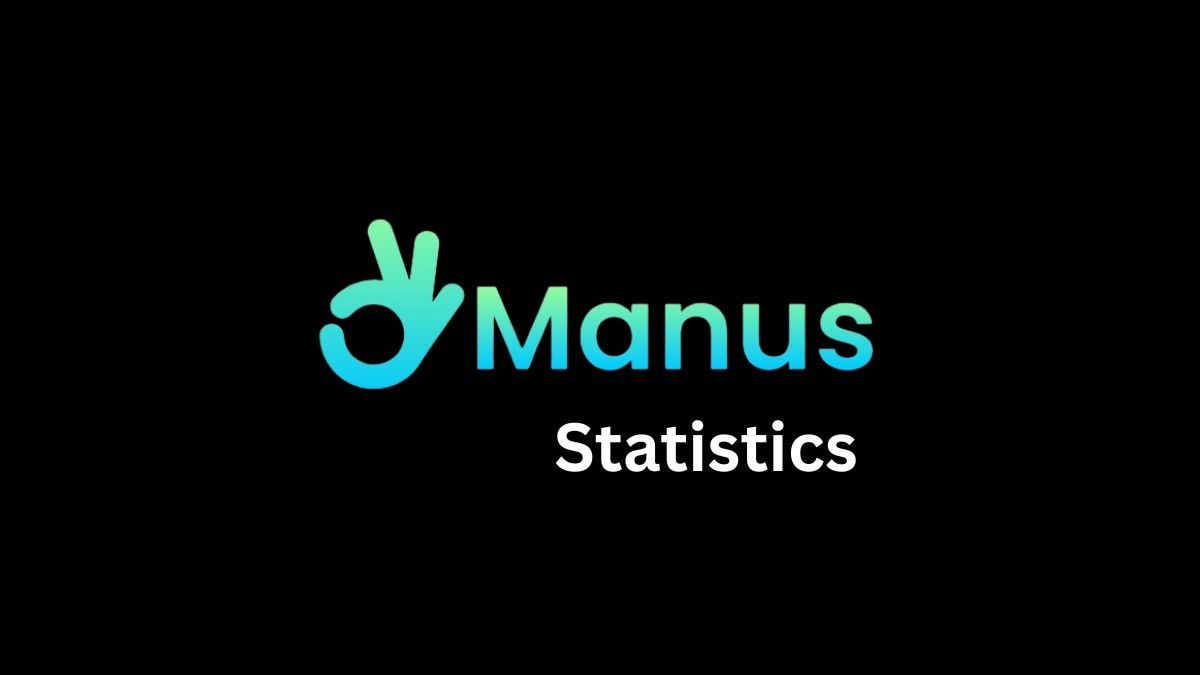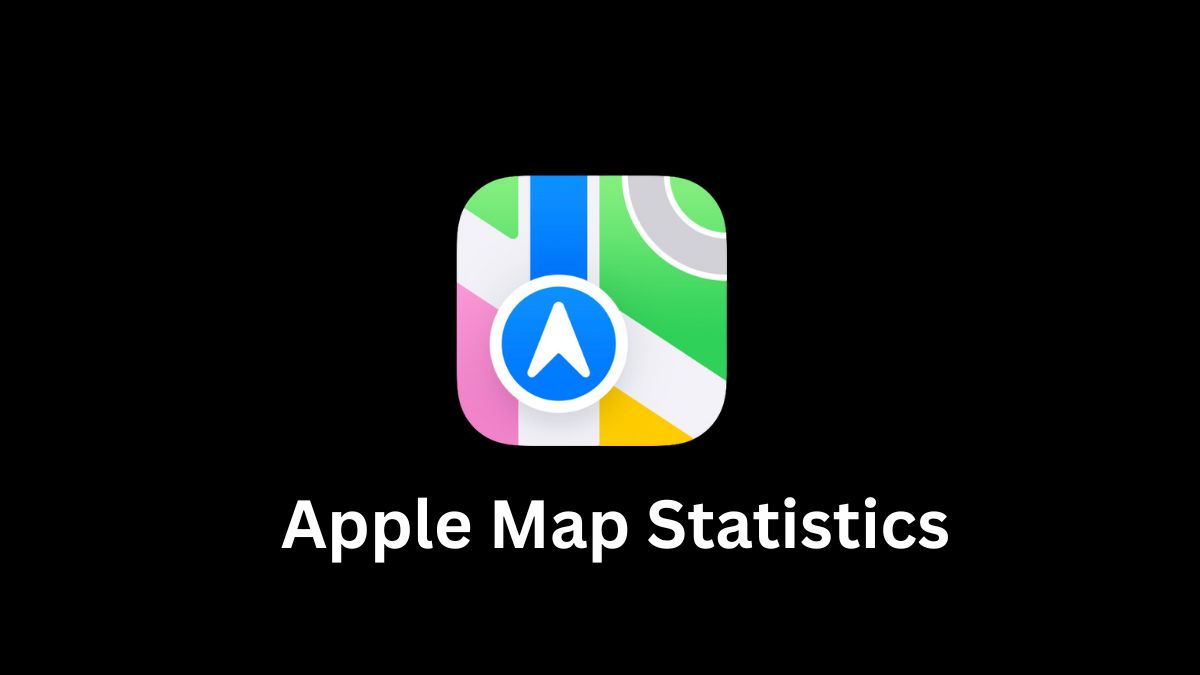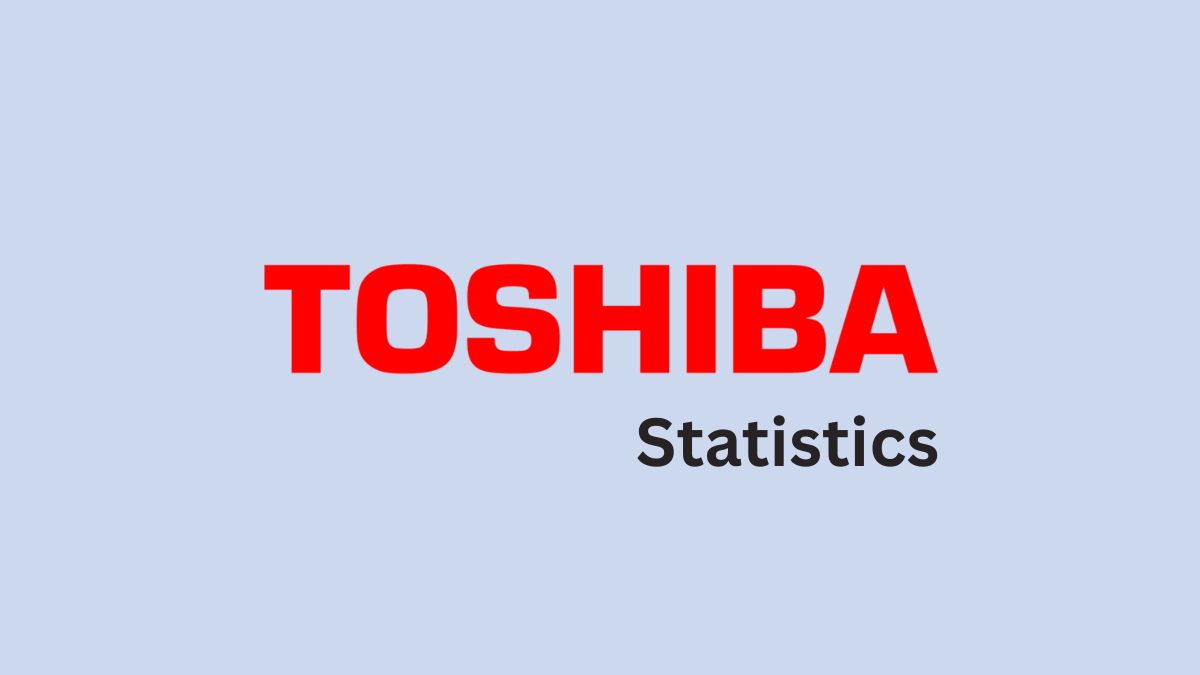HP Statistics By Revenue, Employee, Product Shipment and Facts (2025)
Updated · Nov 04, 2025
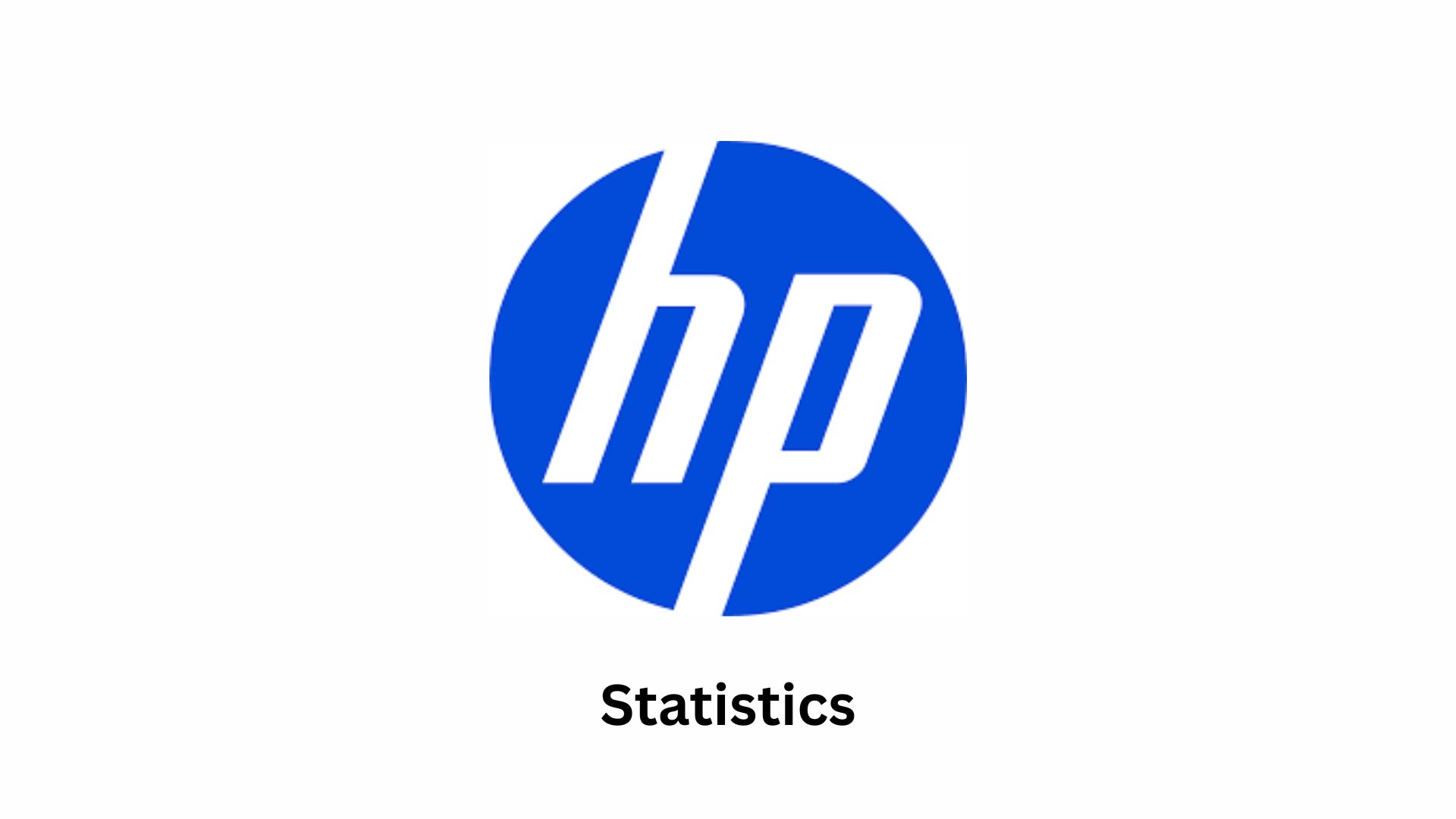
Table of Contents
- Introduction
- Editor’s Choice
- About HP
- Fun Facts About HP Inc.
- History of HP
- Financial Analyses of HP Inc.
- HP Statistics by Revenue and Profits
- By Assets and Liabilities
- HP Market Share
- Number of HP Electronics Shipments
- HP’s Product Shipment Statistics
- HP Stock Price Trend
- Demographics of HP Customers
- HP Social Media Following
- HP Employee Statistics
- HP Employee Tenure and Pay Statistics
- HP Patents Statistics
- HP Website Traffic Statistics
- By Country
- By Device
- By Demographics
- By Traffic Source
- By Social Media Referral Statistics
- Conclusion
Introduction
HP Statistics: HP (Hewlett-Packard) builds everyday technology, starting from laptops and desktop computers to printers and larger systems used by businesses. The company began by creating tools that enabled people and organizations to accomplish more with computers and printing technology. HP now sells a wide variety of devices worldwide and supports millions of customers.
This article on HP Statistics includes several statistical analyses from different insights, including all key HP figures, market share, revenue growth, product sales, and its global presence, which will help provide a clear understanding of where HP stands today and how it’s responding to shifts in technology.
Editor’s Choice
- According to Britannica Money, as of October 28, 2025, a single share was worth US$28.07, which put the company’s total value at approximately US$26.24 billion.
- Over the last year, the business earned US$54.71 billion in revenue.
- Meanwhile, its earnings per share for the previous fiscal year were US$2.75.
- According to hp.com, in the first quarter of 2025, net revenue reached US$13.5 billion, representing a 2.4% increase from the previous year.
- According to hp.com, in the first quarter of 2025, net revenue reached US$13.5 billion, representing a 2.4% increase from the previous year.
- As of July 31, 2025, HP reported total assets of US$39.85 billion, representing a 4.72% year-over-year increase.
- In September 2025, the total number of visits to hp.com was approximately 59.4 million, representing a 0.65% increase from the previous month.
- Meanwhile, the bounce rate of the website resulted in 43.87%.
- The United States accounted for 25.77% of hp.com’s total traffic, a decrease of 8.93 percentage points.
- Moreover, the shares of male and female users on hp.com were 57.98% and 42.02%, respectively.
- The HP Statistics by age group indicate that the highest number of website users observed is between 25 and 34 years old, accounting for 24.86%.
- As of 2025, Organic search generated the highest traffic rate to hp.com, at 47.35%.
- YouTube secured the highest social media referral rate, with a 53.83% share compared to other social network traffic on hp.com.
About HP
| Metrics | Description |
|
Company Name |
Hewlett-Packard |
| Founded |
Started on July 2, 1939. |
|
Founders |
Founded by Bill Hewlett and David Packard. |
| Headquarters |
Based in Palo Alto, California, USA. |
|
Logo (years used) |
The logo shown was used from 1979 until 2010. |
| Type |
A publicly traded company sells shares on stock markets. |
|
Products |
Produced many computer- and technology-related products (see full product list). |
| Traded as |
Listed on the NYSE as HWP (1961 to 2002) and as HPQ (2002 to 2015). |
|
Stock market indexes |
It was included in major indexes such as the S&P 500 (1962 to 2015), S&P 100 (until 2015), and the Dow Jones Industrial Average (1997 to 2013). |
| Industry |
Worked in computer hardware, computer software, IT services, and IT consulting. |
|
Defunct |
The company ceased to exist on November 1, 2015. |
| Successor companies |
HP Inc. (the legal successor), Hewlett Packard Enterprise, and some parts later became DXC Technology, Micro Focus, and Agilent Technologies. |
|
Area served |
Operated and sold products worldwide. |
| Subsidiaries |
Had multiple subsidiaries (see list of subsidiaries for details). |
|
Website |
hp.com |
Fun Facts About HP Inc.
- HP’s first product was the Model 200A audio oscillator, built in a Palo Alto garage in 1938–1939. Its low price and clever light-bulb stabilization came from Bill Hewlett’s thesis work.
- The product name “200A” was chosen to look like an established catalog, and the list price was $54.40 as a playful nod to the “54°40′ or Fight!” slogan from U.S. history.
- Walt Disney Studios bought 8 HP oscillators for theaters screening Fantasia with advanced stereo sound, giving HP an early marquee customer.
- HP’s founders formally established the company on July 2, 1939 in Palo Alto. The garage at 367 Addison Avenue is honored as the “Birthplace of Silicon Valley,” designated in 1989 and later listed on the National Register of Historic Places in 2007.
- “Hewlett-Packard” beat “Packard-Hewlett” by a coin toss, a story recounted in company and museum timelines.
- The HP-35 was the world’s first handheld scientific calculator in 1972. It sold 100,000 units in the first year and over 300,000 in three years, and later received an IEEE Milestone award.
- HP introduced the first desktop laser printer, the LaserJet, in 1984, catalyzing a new market; the line passed 50 million units shipped by 2000.
- HP’s first mass-market personal inkjet was the ThinkJet in 1984, followed by the DeskJet in 1988, which popularized quiet, plain-paper color printing in homes and offices.
- HP’s first computer, the HP 2116A, arrived in 1966 as an instrument controller and marked HP’s first use of integrated circuits.
- The management style “Management by Walking Around” is widely traced to HP’s founders and the “HP Way,” emphasizing direct, informal communication on the shop floor.
- In 2001, HP announced a $25 billion stock deal to acquire Compaq, creating one of the world’s largest PC makers at the time.
- In 2010, HP acquired Palm for about $1.2 billion to pursue webOS devices, then recorded related write-downs totaling about $1.67 billion in 2011 as the effort was wound down.
- HP split into two companies effective November 1, 2015: HP Inc. for PCs and printers, and Hewlett Packard Enterprise (HPE) for enterprise tech.
- The HP LaserJet line became the first commercially successful laser printer family and has remained a reference brand since 1984, often using Canon print engines.
- HP’s sustainability program reports strong circularity progress. In 2024, over 85% of used devices collected via HP’s IT asset disposition service were suitable for refurbishment, helping to avoid e-waste.
History of HP
- 1939: Hewlett-Packard is founded in Palo Alto by Bill Hewlett and Dave Packard; first product is the HP 200A audio oscillator, built in the Packard garage. Disney soon orders units for work on Fantasia.
- 1947: Hewlett-Packard Company is incorporated, succeeding the original 1939 partnership.
- 1957: Public offering is completed to fund expansion and R&D.
- 1963: First major Japan venture is created with Yokogawa to expand test and measurement operations.
- 1966: HP enters computing with its first computer, the HP 2116A, designed as an instrument controller.
- 1968: HP introduces the 9100A, a pioneering desktop scientific calculator.
- 1972: The HP-35, the first handheld scientific calculator, is launched; the HP 3000 minicomputer line debuts for business use.
- 1980: HP-85 desktop computer is introduced as HP expands personal computing efforts.
- 1984: The first HP LaserJet printer is released, becoming a major commercial success.
- 1989: HP announces acquisition of Apollo Computer to strengthen Unix workstations.
- 1995: HP Pavilion consumer PC line launches with the Pavilion 5030.
- 1999: HP spins off its test and measurement, components, and medical businesses as Agilent Technologies.
- 2002: HP completes its merger with Compaq, creating a broad PC and server portfolio.
- 2008: HP acquires EDS for about $13.9 billion, expanding global IT services.
- 2010 (Apr): HP announces and then completes the acquisition of Palm for about $1.2 billion to obtain webOS.
- 2010 (Apr): HP completes the $2.7 billion acquisition of 3Com to bolster networking.
- 2011 (Aug): HP announces plan to acquire Autonomy and reevaluate its PC business focus.
- 2012 (Nov): HP records an $8.8 billion impairment related to Autonomy, citing accounting improprieties.
- 2014 (Oct): HP announces separation into two public companies: HP Inc. (PCs and printing) and Hewlett Packard Enterprise (enterprise portfolio).
- 2015 (Nov 1–2): The split is completed; HPE shares begin trading on Nov 2, 2015, while HP Inc. continues under ticker HPQ.
- 2016 (May): HPE announces spin-off and merger of its Enterprise Services unit with CSC, forming DXC Technology.
- 2019–2020: Xerox launches, then withdraws, a hostile bid for HP Inc.; the effort is abandoned in March–April 2020 amid pandemic uncertainty.
- 2022 (Aug 29): HP Inc. completes acquisition of Poly for an enterprise value of about $3.3 billion to expand hybrid-work solutions.
Financial Analyses of HP Inc.
- According to hp.com, in the first quarter of 2025, net revenue reached US$13.5 billion, representing a 2.4% increase from the previous year.
- The Net cash from operating activities for the quarter was US$0.4 billion, and free cash flow was US$0.1 billion.
- The company returned US$0.4 billion to shareholders through share repurchases and dividends during the quarter.
- Management expects the Future Ready plan to add approximately US$300 million to the annualized gross run rate of structural cost savings, bringing the total to roughly US$1.9 billion by the end of fiscal 2025.
- It forecasts that restructuring and related charges will rise by approximately US$150 million to nearly US$1.2 billion for the year.
- On a GAAP basis, diluted net earnings per share were US$0.59, which falls within the prior guidance range of US$0.57 to US$0.63.
- On a non-GAAP basis, diluted net EPS was US$0.74, also within the previously stated outlook of US$0.70 to US$0.76.
- In 2024, HP reported a slight rebound with revenue of US$53.6 billion and net income of US$2.8 billion. The company maintained a consistent workforce of 58,000 employees, suggesting a focus on steady operations and cost control.
- According to company data from 2023, HP’s revenue dropped further to US$53.4 billion, while net income marginally improved to US$3.2 billion. The workforce remained steady at 58,000, showing organizational stability.
- In 2022, the company’s revenue decreased to US$62.0 billion, and net income fell to US$3.1 billion. Employee count rose to 58,000, reflecting renewed investment in workforce expansion and service operations.
- As per 2021 reports, HP achieved a notable recovery with US$63.2 billion in revenue, while net income increased sharply to US$6.5 billion. The workforce slightly declined to 51,000, indicating operational optimization efforts.
- In 2020, HP recorded a revenue of US$56.5 billion and a net income of US$2.8 billion, maintaining a workforce of approximately 53,000 employees. This year marked stable performance amid global market disruptions.
HP Statistics by Revenue and Profits

- For the quarter that ended on July 31, 2025, HP reported revenue of US$13.93 billion, showing a 3.05% rise from last year’s same quarter.
Furthermore, other analyses are stated in the table below:
| Date | Revenue (USD billion) | Growth Rate (Y-o-Y) |
| 04/30/2025 | 13.220 | +3.28% |
| 01/31/2025 | 13.504 | +2.42% |
| 10/31/2024 | 14.055 | +1.72% |
| 07/31/2024 | 13.519 | +2.45% |
| 04/30/2024 | 12.800 | -0.83% |
| 01/31/2024 | 13.185 | -4.44% |
By Assets and Liabilities
- As of July 31, 2025, HP reported that the total assets accounted for US$39.85 billion, resulting in a growth rate of 4.72% from the previous year.
Other detailed analyses are stated in the table below:
| Date | Revenue (USD billion) | Growth Rate (Y-o-Y) |
| 04/30/2025 | 38.799 | +3.65% |
| 01/31/2025 | 38.930 | +8.60% |
| 10/31/2024 | 39.909 | 7.85% |
| 07/31/2024 | 38.059 | +3.90% |
| 04/30/2024 | 37.433 | +2.93% |
| 01/31/2024 | 35.846 | -0.84% |
- According to industry reports, HP captured a 23.9% market share in 2020, marking a significant gain in the global PC market as demand for laptops, mobiles, and tablets surged during the COVID-19 pandemic.
- In 2021, HP’s market share remained steady between 22% and 24%, reflecting consistent consumer demand and stable performance against competitors like Lenovo and Dell.
- As stated in IDC and Gartner data, HP maintained a similar range of 22% to 24% in 2022, supported by strong shipments and enterprise adoption despite supply chain pressures.
- During 2023, HP’s market share declined slightly to 21.9%, although it still ranked as the second-largest PC vendor globally, closely following Lenovo in total shipments.
- In 2024, HP recorded an increase to 22.6%, reaffirming its position as a leading player in the worldwide PC market, with growth driven by new product lines and rising enterprise demand for hybrid work solutions.
Number of HP Electronics Shipments
- According to industry shipment data, HP distributed 58.4 million PCs and 38.0 million printers in 2020, supported by strong demand for remote work and online education during the pandemic.
- In 2021, HP delivered around 71.4 million PCs and 41.5 million printers, maintaining solid momentum as hybrid working models continued to influence global demand.
- As per market tracking reports, shipments declined in 2022, with 55.0 million PCs and 34.8 million printers, as workplaces and schools reopened, reducing the surge in consumer purchases.
- In 2023, global shipments fell further to 49.5 million PCs and 32.7 million printers, reflecting slower market conditions and cautious consumer spending amid economic uncertainty.
- According to HP’s market projections for 2024, shipments are expected to rebound slightly to 52.0 million PCs and 33.5 million printers, driven by the introduction of AI-enabled laptops, higher demand for premium computing devices, and increased preference for eco-friendly printing solutions.
HP’s Product Shipment Statistics
- According to FoneArena, in Q2 2025, HP shipped approximately 14.1 million personal computers, which is around 20.7 million shipments.
- In the first quarter of 2025, the global PC shipments reached about 63.2 million units.
- IDC reported that in Q1 2025, HP delivered approximately 6.66 million hardcopy peripherals, resulting in 34.4% of the global printer and MFP market.
- In the fourth quarter of 2024, HP shipped approximately 7.5 million units, accounting for a 34.2% market share.
HP Stock Price Trend

- On October 31, 2025, HP shares were valued at approximately US$27.51.
- The stock prices are based on moving averages (50, 200, 100, and 20 days) around US$27.73, US$27.58,
- US$26.52, and US$27.48, indicating steady momentum overall.
- The stock recently touched a high of US$27.88, testing resistance at US$27.66, while major support levels were observed near US$25.55 and US$23.84.
- Earlier highs at US$28.61 and US$29.35 remain important resistance zones for any upward breakout.
Demographics of HP Customers
- According to ElectroIQ, HP’s customer base in North America during 2020 primarily consisted of small businesses (40%), professionals (35%), and students (25%). The age group between 18 and 45 years showed high engagement, mainly due to the rise in remote work and online education. Laptops and printers saw strong demand, and the Pavilion series became particularly popular in India and Southeast Asia.
- In 2021, HP’s North American customers included professionals (40%), gamers (30%), and small businesses (30%). The core age range shifted slightly to 20–50 years. Reports indicated a rise in gaming laptop sales, especially the HP Omen line, along with eco-friendly printers for business users. Hybrid work trends led to higher adoption of multi-functional devices.
- In Europe during 2021, students (35%), professionals (40%), and gamers (25%) formed the main customer groups within the 18–45 age range. According to market insights, this period marked growth in educational and affordable Chromebooks. Demand for smart printers also increased as households adapted to blended work and learning environments.
- In Asia-Pacific in 2021, consumers (55%), small and medium businesses (25%), and students (20%) were the primary segments aged 18–40. Reports highlighted strong interest in budget-friendly laptops and expanding sales of HP Chromebooks in developing markets.
- By 2022, HP’s North American customers included small businesses (35%), gamers (40%), and professionals (25%) in the 20–45 age range. As pandemic-driven demand stabilized, preferences shifted toward high-performance and eco-friendly products. HP expanded its gaming and workstation portfolios to meet evolving user requirements.
- European customers in 2022 comprised gamers (40%), enterprises (30%), and students (30%) aged 18–50. Analysts observed rising interest in energy-efficient devices and high-end gaming systems.
- In Asia-Pacific during 2022, consumers (60%), SMBs (25%), and students (15%) between 18 and 40 years continued to dominate. HP maintained its lead in the mid-range laptop market, particularly among students and young professionals.
- In 2023, HP’s North American market saw gamers (35%), small businesses (30%), and professionals (35%) as core users aged 20–50. According to industry updates, enterprise laptops like the EliteBook series and AI-powered models gained momentum as businesses prioritized performance and sustainability.
- European HP users in 2023 included students (30%), professionals (40%), and gamers (30%) aged 18–50. Analysts noted HP’s focus on sustainable manufacturing and AI-integrated laptops to attract environmentally conscious buyers.
- In Asia-Pacific during 2023, consumers (55%), gamers (30%), and SMBs (15%) aged 18–40 drove the majority of sales. The company strengthened its foothold by promoting AI-integrated and affordable laptops designed for emerging markets.
- By 2024, North American customers were mostly professionals (40%), gamers (35%), and small businesses (25%) in the 20–55 age range. According to regional reports, AI-powered laptops and smart office solutions became leading trends, driven by enterprise digitalization.
- In Europe in 2024, gamers (35%), students (30%), and enterprises (35%) within 18–55 years contributed heavily to market growth. The popularity of hybrid work devices and sustainable products was notable.
- In Asia-Pacific during 2024, consumers (60%), gamers (25%), and students (15%) aged 18–45 dominated HP’s sales. Affordable AI-based laptops and eco-friendly printers were reported as the main growth drivers across India and Southeast Asia.
HP Social Media Following
- According to ElectroIQ, HP’s Facebook followers rose from 5.2 million in 2020 to around 6.5 million in 2024, showing consistent user engagement and content relevance.
- Based on social media insights, Twitter’s follower count increased from 1.3 million in 2020 to nearly 2.4 million by 2024, highlighting stronger brand interactions and real-time communication.
- As per digital trend reports, Instagram followers expanded significantly, moving from 2.1 million in 2020 to approximately 4.0 million in 2024, supported by visual storytelling and influencer collaborations.
- According to LinkedIn performance analytics, HP’s LinkedIn audience grew from 2.5 million in 2020 to nearly 4.2 million by 2024, indicating stronger engagement among professionals and corporate stakeholders.
- As reported by YouTube channel growth data, YouTube subscribers increased from 1.6 million in 2020 to an estimated 2.8 million in 2024, driven by product demos, tutorials, and promotional videos.
| Platform | 2020 | 2021 | 2022 | 2023 | 2024 (Projected) |
| 5.2 Mn | 5.5 Mn | 5.8 Mn | 6.1 Mn | 6.5 Mn | |
| 1.3 Mn | 1.5 Mn | 1.8 Mn | 2.1 Mn | 2.4 Mn | |
| 2.1 Mn | 2.5 Mn | 3.0 Mn | 3.5 Mn | 4.0 Mn | |
| 2.5 Mn | 2.8 Mn | 3.2 Mn | 3.7 Mn | 4.2 Mn | |
| YouTube | 1.6 Mn | 1.9 Mn | 2.2 Mn | 2.5 Mn | 2.8 Mn |
HP Employee Statistics
- According to HP’s annual report, as of October 31, 2024, HP Inc. employed approximately 58,000 people, maintaining the same workforce size as in the previous year.
- In early 2025, the company announced a workforce reduction plan that would eliminate up to 9,000 positions, including an additional 2,000 job cuts beyond earlier estimates.
- Hewlett Packard Enterprise (HPE), which operates separately from HP Inc., reported employing around 61,000 people globally in 2024, marking a 1.61% decline compared to the previous year.
- According to historical company records, HP reached a major milestone in 2007 by surpassing USD 100 billion in annual sales revenue, becoming the first technology company to achieve this figure.
- The company’s gender distribution reflects that nearly 65% of HP’s workforce is male, while around 35% are female employees.

- HP is widely recognized as the “Birthplace of Silicon Valley,” acknowledging its early contribution to the region’s technology development.
- However, in 2014, HP faced legal issues after being found guilty of three instances of bribery involving government officials in Poland, Mexico, and Russia.
- As per salary data, the average annual pay for an HP employee is approximately USD 78,427.
- Reports indicate that an average HP employee has been with the company for about 6.6 years, highlighting relatively stable workforce retention.
- HP’s workforce diversity comprises approximately 54% White, 15.3% Latinx, 15.2% Asian, 10.1% Black or African American, and around 4.9% unknown employees.

- In 2023, HP’s Personal Computing and Printing (HPPC) division employed nearly 51,000 people across various regions worldwide.
- Before the corporate split into HP Inc. and Hewlett Packard Enterprise, the combined organization had an estimated 300,000 employees globally.
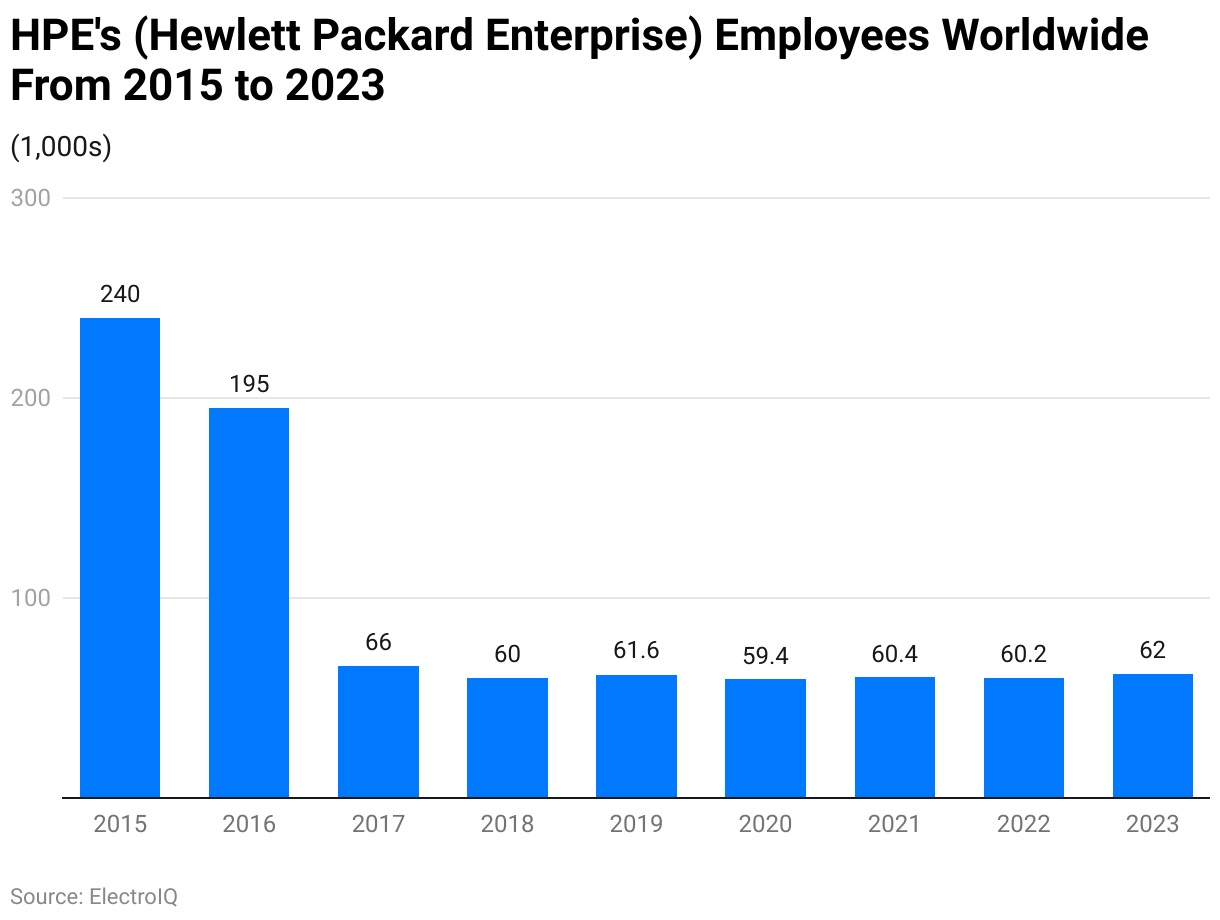
- According to company data, by 2023, HP Inc., headquartered in California, had about 58,000 employees worldwide.
- The company is mainly involved in producing personal computers (PCs), printers, and other related devices.
- Reports indicate that most of HP’s revenue comes from the sale of desktop and laptop computers, while the remaining portion is generated from printers and printing supplies used by both businesses and individuals.
- Based on workforce studies, around 62% of HP employees hold at least a bachelor’s degree, making it the most common level of education among its staff.
HP Employee Tenure and Pay Statistics
- Most HP employees stay with the company for 1–2 years, representing about 29% of the total workforce.
- Long-term employment at HP is less common. Only 8% of employees remain with the company for 8–10 years.
- The largest portion of HP’s workforce earns between USD 100,000 and USD 200,000 annually, accounting for approximately 61% of employees.
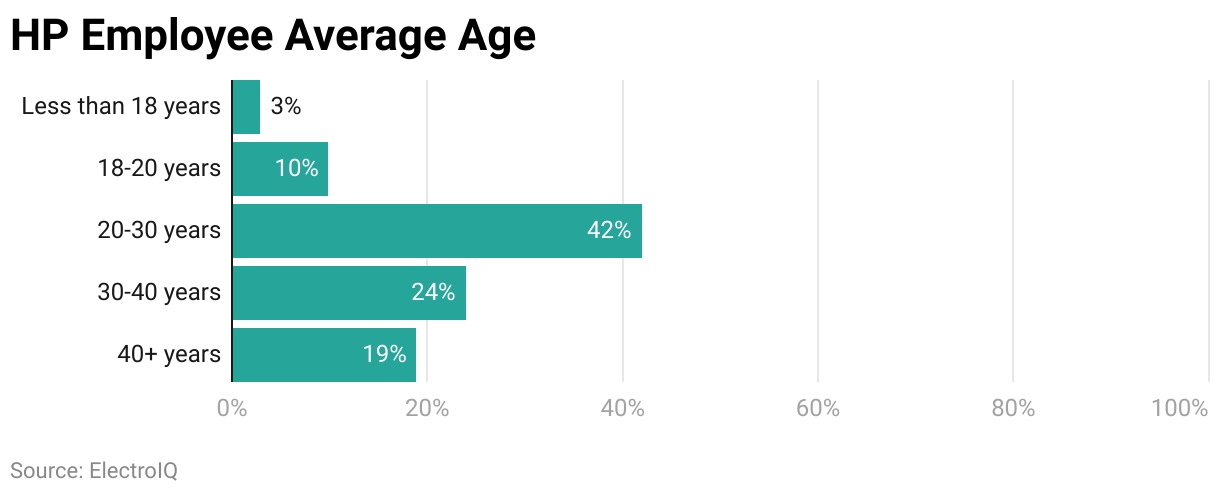
- A smaller group earns between USD 60,000 and USD 100,000, with over 5,000 jobs in this range.
- Around 956 employees fall within the USD 40,000–60,000 annual salary range.
- Only about 3% of employees, or 555 individuals, earn between USD 25,000 and USD 40,000 per year, making it the least common salary range.
- Very few positions, approximately 6 jobs, fall below the USD 25,000 annual income mark.
- In comparison, IBM has a larger number of higher-paying roles, with 25,093 jobs in the USD 100,000–200,000 bracket and 142 jobs paying above USD 200,000 annually.
| Salary Range | HP | IBM |
| >USD 200k | 49 JOBS |
142 JOBS |
|
USD 100k-200k |
10,671 JOBS | 25,093 JOBS |
| USD 60k-100k | 5,166 JOBS | 77,583 JOBS |
|
USD 40k-60k |
956 JOBS | 5,000 JOBS |
| USD 25k-40k | 555 JOBS | 909 JOBS |
|
<USD 25k |
6 JOBS | 13 JOBS |
HP Patents Statistics
- According to patent data reviewed on October 7, 2024, Hewlett-Packard (HP) holds 22,376 patents worldwide, of which 14,923 have been granted, and about 59% remain active.
- Global patent statistics from 2023 indicate a 2.7% increase in overall patent applications, reaching 3.55 million filings, showing continued innovation across industries.
| Years of Patent Filing | HP Applications Filed | HP Patents Granted |
| 2022 | – | 90 |
| 2021 | 339 | 843 |
| 2020 | 578 | 1132 |
| 2019 | 972 | 1130 |
| 2018 | 1063 | 722 |
| 2017 | 692 | 720 |
| 2016 | 1193 | 899 |
| 2015 | 2173 | 978 |
| 2014 | 1474 | 917 |
| 2013 | 1535 | 763 |
| 2012 | 1483 | 800 |
| 2011 | 1029 | 683 |
- Reports show that the United States leads in the number of patents filed by HP, followed by Europe and China, confirming its strong presence in developed technology markets.
- HP, founded in 1939 by Bill Hewlett and David Packard, is headquartered in California, USA, and is recognized as one of the leading multinational IT companies globally.
- Based on intellectual property databases, HP’s patent portfolio covers diverse technology areas, including computing hardware, imaging systems, and digital printing.
- Patent citation analysis indicates that IBM, Microsoft, and the Bank of New York Mellon Trust are among the top organizations citing HP’s patents, reflecting HP’s technological influence in IT innovation.
- As noted by industry experts, a high citation rate of patents signifies that HP’s research and innovations are influencing other organizations and driving further advancements in related technologies.
- Analysts from global patent offices have stated that the apparent decline in HP’s published patents in the last two years does not necessarily imply reduced innovation activity, since patent publications typically appear 18 months after filing.
- HP’s strong patent presence in countries such as the United States (14,845), Europe (1,656), China (1,574), Germany (1,090), and India (326) demonstrates its extensive R&D network and global intellectual property footprint.
- Other nations with notable HP patent filings include Japan (74), Korea (158), Taiwan (307), UK (413), Brazil (32), and Canada (27), showing strategic diversification of innovation centers worldwide.
- According to technology analysts, the continued patenting activities in regions such as Asia-Pacific and Europe indicate HP’s focus on expanding innovation in high-growth technology sectors.
- The distribution of patents across over 20 countries reveals HP’s commitment to maintaining global competitiveness through localized R&D and protection of proprietary technologies.
- Industry observers emphasize that HP’s active portfolio supports its long-term strategy in printing technology, cloud infrastructure, and computing solutions, aligning with global digital transformation trends.
In the above chart, we can see the countries in which HP has filed Patents.
| Nations | Patents |
| Philippines | 1 |
| Czech Republic | 1 |
| Kazakhstan | 1 |
| Sweden | 1 |
| Mexico | 1 |
| Viet Nam | 1 |
| Poland | 1 |
| Spain | 3 |
| Saudi Arabia | 3 |
| Denmark | 3 |
| Finland | 3 |
| New Zealand | 7 |
| Malaysia | 7 |
| Israel | 7 |
| Austria | 8 |
| Singapore | 17 |
| Canada | 27 |
| Australia | 29 |
| Hong Kong | 31 |
| Brazil | 32 |
| Japan | 74 |
| Korea | 158 |
| Taiwan | 307 |
| India | 326 |
| UK | 413 |
| Germany | 1090 |
| China | 1574 |
| Europe | 1656 |
| US | 14845 |
HP Website Traffic Statistics
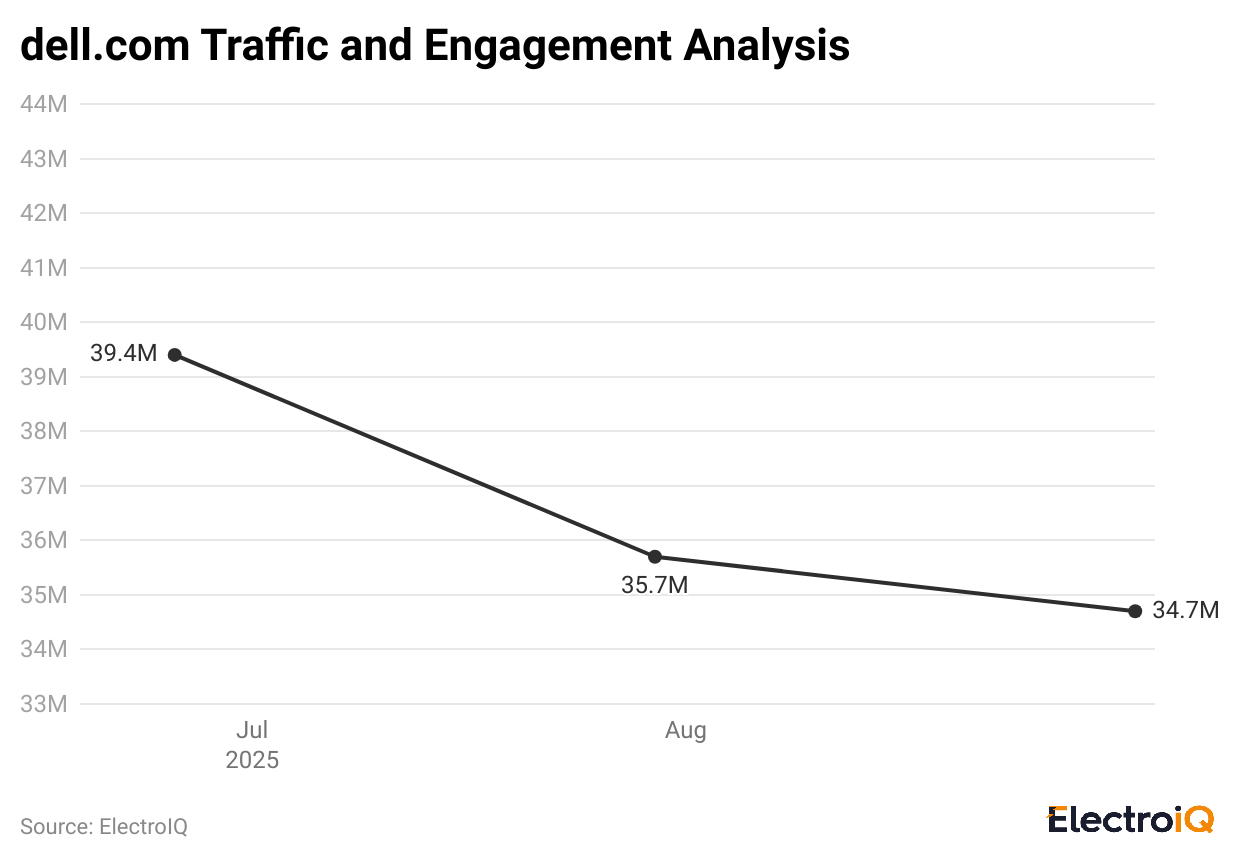 (Reference: similarweb.com)
(Reference: similarweb.com)
- In September 2025, hp.com secured approximately 59.4 million visits, with a 0.65% increase from the previous month.
- The website’s bounce rate was 43.87%.
- The total number of pages per visit on hp.com was 4.72, and the average visit duration was 4 minutes and 19 seconds.
- Global rank of the website was #606; country-wise ranked #482 (United States); and category-wise ranked #5.
- In the same period, the global ranking of the website increased from 646 to 606 between July and September.
By Country

- In September 2025, the United States of America accounted for 25.77% of hp.com’s total traffic, a decrease of 8.93%.
- During the same period, other countries made the following contributions to total traffic: India: 8.48% (-1%); Japan: 7.85% (+15.92%); the United Kingdom: 4.12% (+10.79%); and Germany: 3.76% (+2.51%).
- Other countries collectively accounted for around 50.01% of the visitors shared on HP’s website.
By Device

- As of 2025, hp.com received the highest website traffic from the United States, accounting for 30.21% of total visitors, or approximately 22.51 million users. The web traffic is segmented between mobile (58.59% and desktop (41.41%) access.
- India follows with 11.54% of traffic, equivalent to 8.6 million visitors, where 77.43% use mobile devices and 22.57% use desktop devices.
- The United Kingdom ranks third, with 4.67% (approximately 3.48 million users), comprising 60.56% mobile and 39.44% desktop users.
- Germany contributes 4.22% of total visits, totalling 3.14 million, with 56.04% of access via mobile devices and 43.96% via desktop.
- Japan accounted for 3.65% of hp.com’s users, with around 2.72 million visitors, with 42.9% using mobile devices and 57.1% using desktops.
By Demographics

- In September 2025, the share of male and female users on hp.com was 57.98% and 42.02%, respectively.
- The HP Statistics by age group indicate that the highest number of website users observed is between 25 and 34 years old, accounting for 24.86%.
- Approximately 20.71% of HP’s website users are between 35 and 44 years old.
- In contrast, 17.7% and 15.8% of users were aged 45 to 54 years and 18 to 24 years, respectively.
- Around 12.48% of HP’s website users are aged between 55 and 64 years, while 8.45% aged 65 years and above.
By Traffic Source

- During the same period, organic search generated the highest traffic rate to hp.com, at 47.35%.
- Almost 39.07% of the share comprises direct traffic, while paid search generated around 6.57%.
- Others are followed by referrals (4.77%), display (1.75%), social (0.4%), and mail (0.08%).
By Social Media Referral Statistics

- YouTube secured the highest social media referral rate, with a 53.83% share compared to other social network traffic on hp.com.
- Facebook and X-twitter each contributed a share of 13.98% and 9.09%, respectively.
- Approximately 8.17% and 5.1% of website traffic were attributed to Reddit and WhatsApp Web apps, respectively.
- Other social media segments of the website collectively accounted for 9.83%.
Conclusion
HP has remained a reliable tech brand by delivering steady results and offering a wide range of products. It provides laptops, printers, and enterprise solutions to both individual users and large businesses, continually innovating to stay current with digital trends. Customers continue to respond well to its focus on quality and steady improvements, so the business looks set to expand further in the years ahead.
Sources
FAQ.
HP produces laptops, desktops, printers, ink/toner, workstations, servers, storage, and software/services for home and business.
No. HP Inc. focuses on PCs and printers. Hewlett Packard Enterprise (HPE) provides enterprise servers, storage, and networking solutions.
Yes. HP provides standard warranties and optional extended care plans (e.g., Care Packs).
HP includes built-in hardware and software security features, providing enterprise-level protection and management services.
Visit HP’s support website, enter the product’s serial number, and then register it or view its warranty information.

Maitrayee Dey has a background in Electrical Engineering and has worked in various technical roles before transitioning to writing. Specializing in technology and Artificial Intelligence, she has served as an Academic Research Analyst and Freelance Writer, particularly focusing on education and healthcare in Australia. Maitrayee's lifelong passions for writing and painting led her to pursue a full-time writing career. She is also the creator of a cooking YouTube channel, where she shares her culinary adventures. At Smartphone Thoughts, Maitrayee brings her expertise in technology to provide in-depth smartphone reviews and app-related statistics, making complex topics easy to understand for all readers.



